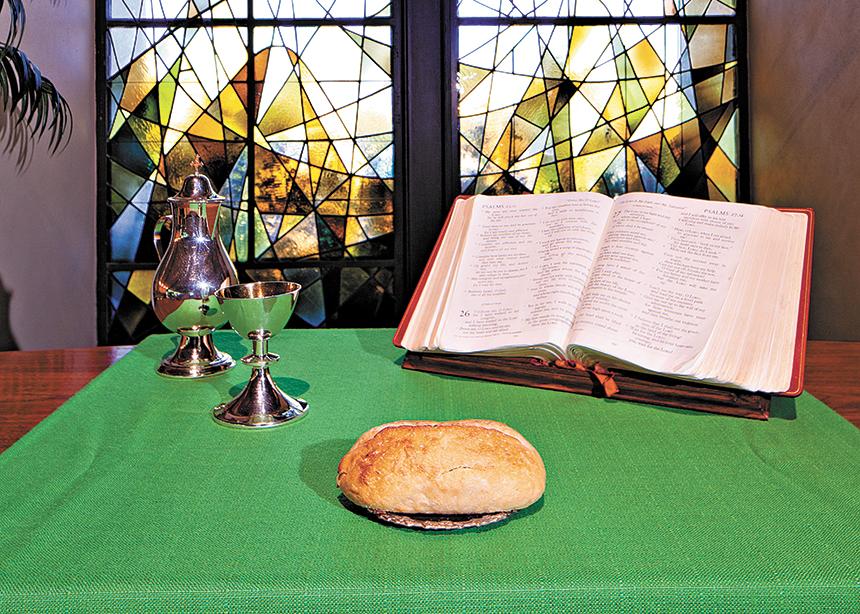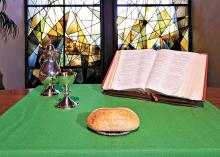“Then he took a loaf of bread, and when he had given thanks, he broke it and gave it to them, saying, ‘This is my body, which is given for you. Do this in remembrance of me.’ And he did the same with the cup after supper, saying, ‘This cup that is poured out for you is the new covenant in my blood’” (Luke 22:19-20 NRSV).
Many Mennonites have grown up hearing these words for as long as they can remember. Communion, the Lord’s Supper or Eucharist; whatever the name, it has been an integral part of the Christian faith since its beginnings.
Communion in Mennonite churches in Canada hasn’t always looked the same over the years. In the 1960s and ’70s, many churches had separate services for communion, which only baptized members attended. Over time, the ritual was incorporated into Sunday morning worship and then began to involve non-baptized participants in alternative ways as well.
Today, there is an undeniable move towards open communion in Mennonite Church Canada congregations. From B.C. to Ontario, all 10 people interviewed for this article noted that it was a trend in their region.
“There’s a shift in church in terms of where the emphasis is placed—a shift from what you believe to who belongs,” says Tanya Dyck Steinmann, pastor of East Zorra Mennonite Church in Tavistock, Ont.
This trend follows a larger societal movement pushing for inclusion and acceptance. “We have a major concern for inclusivity and welcome, and more and more people are interpreting that as meaning we should have some level of open communion,” says John Rempel, a Senior Fellow at the Toronto Mennonite Theological Centre. At the Mennonite World Conference assembly in 2015, Mennonites who filled the stadium were invited to celebrate the Eucharist together, regardless of baptism or age.
In 2008, Elsie Rempel wrote an article for Canadian Mennonite entitled “Kids & communion: Towards a more inclusive approach.” Ten years later, she reflects on why the trend of open communion is stronger now.
“[It’s] partly because of children and wanting to include them more holistically in the worship life of the church,” she says, “but also because . . . more and more young adults are reluctant to get baptized, even though they have sincere faith.”
John Rempel adds that the church is in an age when it’s far more uncertain whether children will end up sharing the faith of their parents, so parents want to show their kids they belong in the church.
For some, it's the context that makes all the difference.
Home Street Mennonite Church in Winnipeg has a well-established practice of open communion. It provides a variety of options to congregants: the traditional bread and grape juice, grapes and crackers, or just a blessing. All three options are open to everyone.
Pastor Judith Friesen Epp says open communion at Home Street is particularly important because of its geographical location: “Home Street, in its entire 60-year history, has always been located near the centre of the city, in neighbourhoods where there’s significant poverty and . . . racism, and where many people are unwelcome in a lot of places.” She says that when people from the neighbourhood come to worship, the first and most important message they hear must be, ‘You are welcome, you’re accepted here and you belong.’ ”
But even churches with more traditional views and practices are switching to more inclusive communion practices. It was surprisingly difficult to find a church that still reserved communion for baptized believers only. One pastor in southern Manitoba said that the only churches in the area he could think of that still practised a more “closed” communion had all left the regional church by now.
Along with opening the communion table comes a fundamental shift in the meaning behind communion. Article 12 in the Confession of Faith in a Mennonite Perspective states that, at the communion table, “we renew our baptismal covenant with God and with each other.” If many people who have never made a baptismal covenant before are now taking communion, then its significance is changing in a significant way for many people.
This is an important transformation of meaning that many churches are dealing with. So why hasn’t the debate heated up?
“It’s much more fun to argue about sex than communion,” says Elsie Rempel with a laugh. One of the reasons she did her master’s thesis on Mennonites, children and communion a decade ago, and created the booklet “Come Lord Jesus, be our host,” was because she wanted to provide the church with resources when they struggled with what she expected to become a big deal. “I thought it would catch on, but it didn’t,” she says. “I think people were just so preoccupied with this sexuality conversation,” she says. “I don’t think it’s that communion doesn’t matter, but maybe there’s only [enough] emotional energy for one big fight at a time.”
This isn’t to say everyone is just jumping on board with no questions.
Dyck Steinmann says that, while East Zorra’s new open communion model has been quite well received, it hasn’t necessarily been an easy journey. It began when the pastors felt called to make communion more inviting. But when they first changed the wording of their invitation, it created confusion for those who weren’t yet baptized, because of the church’s strong tradition of communion being reserved for baptized believers. This prompted a process of discernment with the congregation, which led to a shift to open communion in 2015.
She says this is a big adjustment for the traditional congregation. One concern people had was that the new model would compromise the meaning of communion. “There was a valid fear that communion would become meaningless and wishy washy if everyone was free to participate,” she says, adding, though, that communion can actually lead to deeper faith commitment and isn’t just a reward of baptism.
East Zorra is in an area that has a strong Amish tradition, which places a lot of pressure on being worthy and ready for communion. The pastors wanted to create space for grace and to acknowledge that everyone is imperfect and at different points along the faith continuum.
Not all churches have instantly started believing the same thing either.
At First Mennonite Church in Winnipeg, all who are baptized are invited to communion, which is bread and a choice of juice or wine passed down the pews. The church currently doesn’t have an alternative for children or unbaptized congregants. Pastor David Driedger says there hasn’t been a significant enough push from the congregation to change from its current tradition.
“It seems that expression continues to resonate with enough of the membership that it has simply continued in a very stable form over the years,” he says, adding that it’s a matter of which commitments the church believes come first on the path of discipleship. Other churches might put those in a different order or on a different level of importance.
There are many aspects of worship at First Mennonite to which everyone is welcome, and there are many ways to get involved, whether baptized or not. Driedger says that communion is also not the only table at which Christ is present, including the fellowship meal. The communion table is just one that holds an especially important significance.
Whether it’s saved for a specific time or open to anyone who desires it, it’s clear that communion is still very important for the Mennonite church.
“Where language has become hackneyed and people become inattentive to it . . . a simple but beautifully crafted ritual of communion can sometimes speak to people about the meaning of Christ and the meaning of the Christian life in a way that words don’t seem to,” says John Rempel. Communion engages our bodies and requires active participation in worship and with each other.
This is especially important for Mennonites because, other than singing, our worship so often uses only our brains. “[Communion is] so holistic,” says Elsie Rempel. “It’s not just the head . . . it’s ritual that involves all our senses, that . . . renews the relationship between us and God in a very tangible way.”
For churches that still teach baptism should come before communion, there are other ways to create an inclusive space. In her thesis, Elsie Rempel proposed that those who were baptized receive the elements and people who hadn’t made that step yet receive a grape. A grape is theologically significant because it is on its way to becoming wine but hasn’t gone through the whole process yet, she says. While a blessing can also be meaningful, it still misses the action element of the ritual, which is so important. “There’s something about being fed by God that nourishes us in a spiritual way,” she says.
Many churches that practise open communion still want to recognize the importance of baptism and membership.
Friesen Epp says that a public commitment to both Christ and the church community is still important at Home Street. “We also want to continue to hold that strong Anabaptist principle . . . we just maybe need to do that in another place and another way,” she says.
In this evolving church landscape, with more open communion tables than ever before, we must enter the Lord’s Supper asking both the question, “How are we welcoming others?” and also, “How are we calling people to a commitment to follow Jesus?”
Communion then and now
In the April 28, 2008, article, “How three churches offer communion,” Canadian Mennonite described how children participated in the service. Here’s a glimpse of where those churches are at now, a decade later.
Lethbridge (Alta.) Mennonite Church
In 2008, deacons served communion to adults in the pews, and children could receive a blessing from them by using the sign language of crossing their arms across their chest. They received pretzels as a reminder of the “hug” sign for the blessing.
Today, the communion elements sometimes pass along the rows, but most often the congregation comes forward, taking the bread and dipping it in the goblet of juice and eating right away. Communion is open to anyone who claims Christ as saviour, says Kevin Neufeldt, worship committee member and former church deacon. Baptism is not specified, and there is an option for non-baptized members to receive a blessing and grapes, if they so desire.
Sherbrooke Mennonite Church, Vancouver
Ten years ago, baptized believers were invited to take communion a total of five times a year, and those anticipating baptism in the future were offered grapes and crackers. Many felt this compromised the meaning of communion, so the future of the grapes and crackers was uncertain.
Today, communion is open to anybody who is a follower of Christ, without a requirement for baptism, says Phil Routly, the church’s current transitional pastor. Grape juice and crackers or gluten-free bread are passed down the rows in a monthly communion service.
East Zorra Mennonite Church, Tavistock, Ont.
A decade ago, the regular practice was to include only baptized believers in the communion service. However, the church was also experimenting with offering grapes and crackers to those who weren’t baptized but who looked forward to that in the future. The addition was well received by the congregation.
Today, East Zorra practises open communion, meaning followers of Christ can participate, whether baptized or not. This is the result of a discernment process the church worked through in 2015, says Pastor Tanya Dyck Steinmann. The bread and grape juice are served in the aisles, along with pretzels and grapes for those who don’t wish to take full communion yet.
For discussion
1. Is the ritual of communion always the same in your congregation? How do congregants choose whether or not to participate? What are some different ways of serving communion? Do you remember members-only services for communion?
2. Has your congregation shifted towards more open communion over the years? How much discussion was there about this change? How does the meaning of communion change when there is no expectation of membership? What happens to the expectation of a faith commitment? If we welcome children to the communion table, does that diminish the meaning of adult baptism?
3. John Rempel and Elsie Rempel say that the ritual of communion can engage our bodies and our senses in a way that words can’t, making it an important way to renew our relationship with God. Do you agree? What role does communion play in your journey of faith?
4. How do you prepare yourself for communion? What do you understand to be the meaning of I Corinthians 11:27-29, where Paul tells the Corinthians to examine themselves and not to eat the bread and drink the cup in an unworthy manner?
—By Barb Draper






Comments
Perhaps readers of the Canadian Mennonite might wish to consult an insightful book by Dorothy Sayers called "Creed and Chaos." In it Sayers argues with strong effect for creedal formulations as embraced by the early church as foundational to Christian faith. Christian faith without creedal content leads to chaos, according to Sayers.
I appreciate Klassen-Wiebe’s article on the role and place of communion for Mennonite Church Canada congregations. She raises good questions for our discussion.
While the article and interviews focus on the role of communion as “inclusion and acceptance” for children and those on the fringe of the church, I was left feeling something missing.
Over the years I’ve provided leadership for communion services in a variety of settings it has been important to “prepare” for receiving Christ’s body and blood (1 Cor. 11:27). In traditions of the churches I’ve served, the week prior to communion it has been important to preach a message of preparation; a time to prayerfully evaluate and address one’s relationships.
Connected to this is the trend of young adults hesitant to request baptism and membership with the church. Critiques I’ve heard in response are not unfounded, indicating church communities are themselves in need of some “self-examination.” However, the point remains, Mennonite Churches practice “believer’s baptism,” not “adult baptism.” This is an important distinction when it comes to discussion of communion.
When Elsie Rempel says, “It’s much more fun to argue about sex than communion,” she makes an important connection with the two topics. In recent times there has been a shift to accepting sexual relations prior to a commitment of marriage, and acceptance of open inclusion for communion prior to a commitment of belief. I don’t believe either of these trends are what the Spirit of God intends for our blessing.
While affirming the desire for all people to feel included and accepted in Christian worship, I understand a significance of believing in the life, death, resurrection and return of Jesus Christ. When the church abandons belief to following Jesus in daily life, it becomes a “registered charity doing social work.” Believer’s baptism is the public declaration that Jesus makes all the difference in one’s life. As I understand, communion is the affirmation of one’s baptism vows and commitment as a member of the community of faith.
Add new comment
Canadian Mennonite invites comments and encourages constructive discussion about our content. Actual full names (first and last) are required. Comments are moderated and may be edited. They will not appear online until approved and will be posted during business hours. Some comments may be reproduced in print.